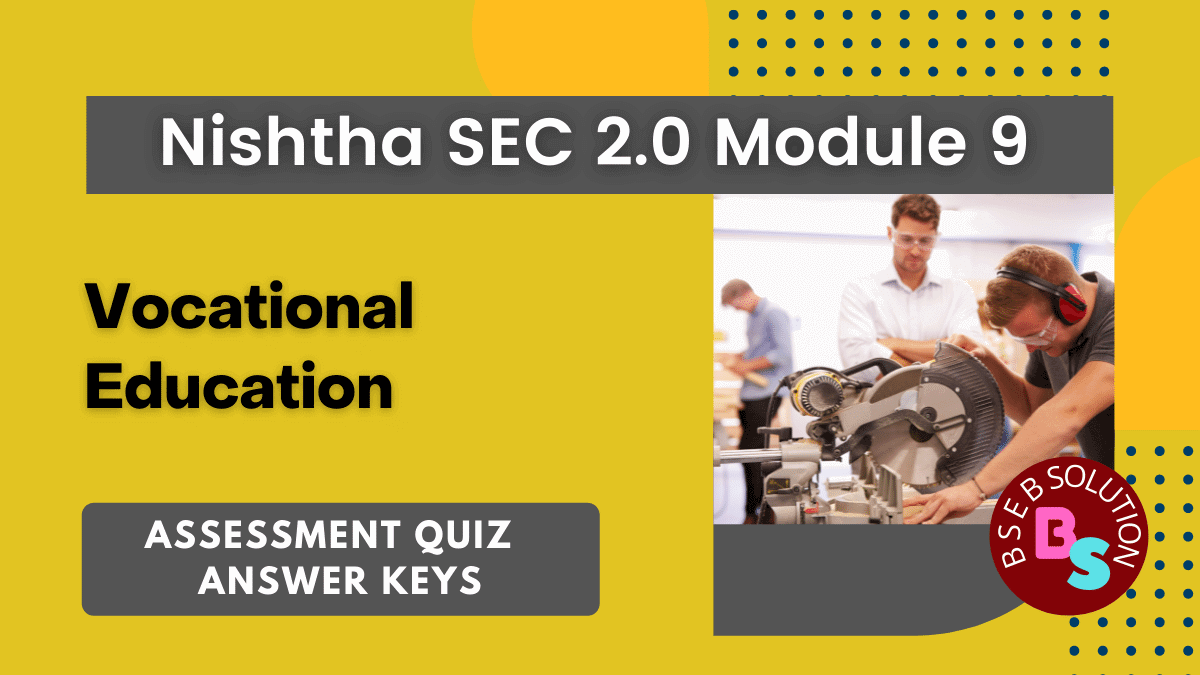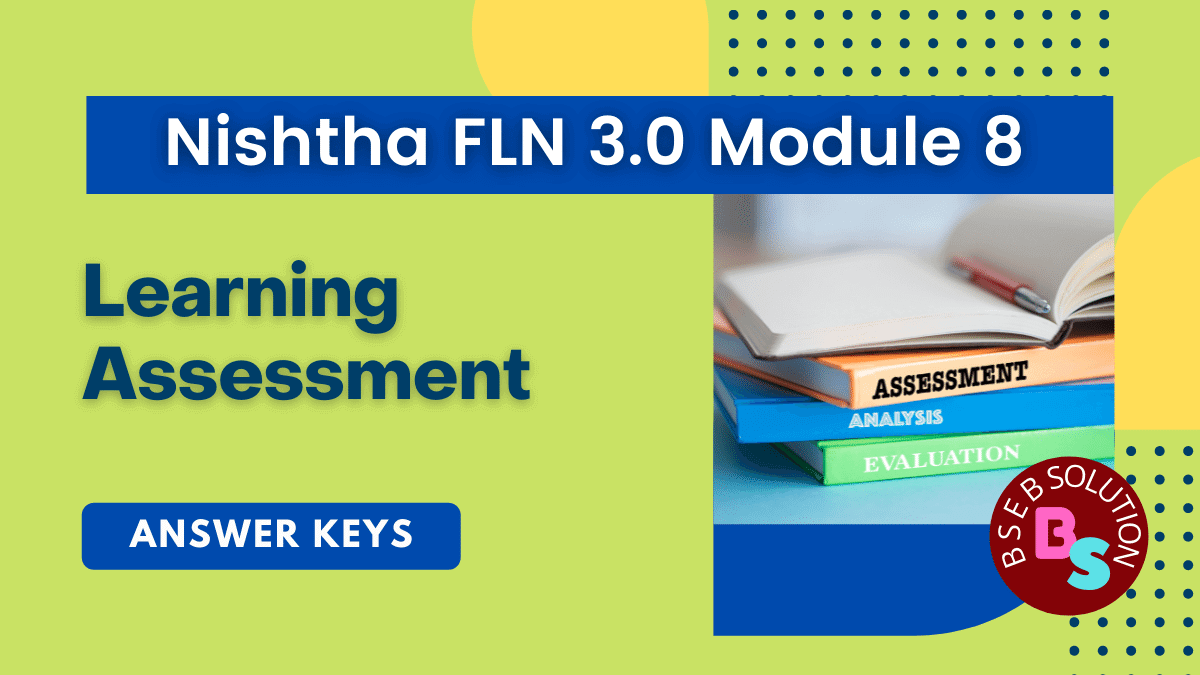This module focuses on integration of vocational education with general education and discusses the modalities adopted for providing opportunities to the students for vocational preparation from Grades IX to XII under the Samagra Shiksha-an integrated scheme for school education. In this post you will be able to know “Vocational Education” AR, UP, UK, MZ, NL, OD, PB, AP, AS, BH, GJ, HR, HP, JK, JH, KA, MP, CHD, CG, DL, GA, MH, CBSE, KVS, NVS, MN, ML, RJ, SK, TS, TR, Nishtha SEC 2.0 Module 9 Quiz question and Answer Key PDF in English for Secondary School Teachers of all states. If you want this questionnaire in Hindi, click here.
“Vocational Education” Nishtha SEC 2.0 Module 9
The assessment questionnaire of Nishtha 2.0 and 3.0 training is the same in all states, but the Training Links are different. Out of around 40 questions, you will get only 20 random questions in an attempt. You will be able to get the certificate by scoring 70% marks in maximum three attempts.
All the Nishtha trainings available on Diksha App are design to improve teacher performance. So, take all the training seriously and solve the assessment quiz at the end. Certificate will issued only after securing 70% marks in the evaluation quiz. If you face any kind of problem in solving Nishtha SEC 2.0 Module 9 Quiz then get complete solution here.
Nishtha SEC 2.0 Module 9 Answer Key
Q. 1: In vocationalisation of education…… for vocations will help students participate in activities that integrate academic skills with vocational skills.
- Exploration
- Awareness
- Preparation
- Guidance
Q. 2: Regional Boards of Apprenticeship Training (BOAT) are at
- Mumbai, Delhi, Chennai, and Udaipur.
- Pune, Kolkata, Bhopal, and Kanpur.
- Mumbai, Kolkata, Chennai, and Kanpur.
- Bengaluru, Vijayawada, Indore, and Kanpur.
Q. 3: A separate Ministry of Skill Development and Entrepreneurship was created in
- 2016
- 2012
- 2013
- 2014
Q. 4: Which model, according to NEP 2020, will be used to set up the Skill Labs in the schools in order to allow other schools to use the facility?
- Point-to-Point
- Institution-based model
- Hub and Spoke
- Decentralised Model
Q. 5: The recognition of qualifications awarded to learners by the industry or employers across the country depends on
- The resource availability of VET
- The quality and access of VET
- The skill standards and delivery of VET
- The marketing of the VET
Q. 6: Vocational…….. will help students to learn about various occupations and career options in the world of work.
- Skill
- Understanding
- Awareness
- Knowledge
Q. 7: At the end of Grade X and XII external assessment and evaluation of skill component of vocational students is to be taken up by the
- Department of School Education
- Schools
- Sector Skill Council
- National Skill Development Agency
Q. 8: NATS stands for
- National Apprenticeship Training Scheme
- National Apparel Training Scheme
- National Apprenticeship Training System
- National Applied Training System
Q. 9: Under the Samagra Shiksha Work Education (WE), which was earlier known as Work Experience or Socially Useful Productive Work (SUPW) will be offered from
- Grades 4 to 6
- Grades 1 to 4
- Grades 1 to 5
- Preschool to Grade 3
Q. 10: Vocational will help students to understand what people do for living and skills needed for various occupations.
- Knowledge
- Exploration
- Skill
- Wellness
Q. 11: To facilitate mobility across ‘general education’ and ‘vocational education’ has been recommended by the National Education Policy 2020
- Credit-based Framework
- Rank-based Framework
- Course-based Framework
- Point-based Framework
Q. 12: According to National Education Policy 2020, internship
opportunities to learn about vocational subjects, may be made available to students throughout Grades including holiday periods.
- 6 – 8
- 8 – 10
- 9 – 11
- 6 – 12
Q. 13: ………….was enacted with the objective of regulating the programme of training of apprentices in the industry (industry means any industry or business in which any trade, occupation or subject field in engineering or non-engineering or technology or any vocational course may be specified as a designated trade or optional trade or both) by utilising the facilities available therein for imparting on-the-job training.
- The Apprentices Act 1971
- The Apprentices Act 1956
- The Apprentices Act 1981
- The Apprentices Act 1961
Q. 14: The apprenticeship training under the National Apprenticeship Training Scheme (NATS) is a _– year programme equipping technically/vocationally qualified youth with practical knowledge and skills required in their field of work.
- One
- Three
- Four
- Two
Q. 15: National Policy on Skill Development and Entrepreneurship (2015) focuses on an approach towards quality skilling.
- Outcome-based
- Traditional
- Informal
- Input-based
Q. 16: A Vocational Teacher/Trainer should possess the knowledge and skills of teaching and what is to be taught to the learners.
- Narration
- Practicing
- Comprehension
- Understanding
Q. 17: The framework for Recognition of Prior Learning for recognising the learning experience acquired outside a formal setting and providing a government certificate
- National Curriculum Framework (NCF)
- National Skills Qualifications Framework (NSQF)
- National Curriculum Framework for Teacher Education (NCFTE)
- National Curriculum Framework for School Education (NCFSE)
Q. 18: Challenges that the VET faces-
i. Negative perception and image of VET in society
ii. Lack of awareness among the stakeholders
iii. Mismatch between the skills demand and supply
iv. Shortage of qualified and professionally trained Vocational Teachers/ Trainers
- i, ii, iii and iv
- Only ii, iii and iv
- Only i, ii, and iv
- Only i, ii and iii
Q. 19: According to the recommendations of the Secondary Education Commission 1952-53, the aim of vocationalisation of education is
- To improve the vocational efficiency of the students
- To improve the vocational monitoring of the students
- To improve the marks of the vocational students
- To improve the vocational assessment of the students
Q. 20: NOS stands for National Occupation ……
- Structure
- System
- Sample
- Standards
Q. 21: ………. will be formulated by the General Education Council (GEC) and it shall be in sync with the NSQF
- National Curriculum Framework for Vocationa Education (NCFVE)
- National Qualifications Framework for Higher Education (NQFHE)
- National Higher Education Qualification Framework (NHEQF)
- National Occupational Qualifications Framework (NOQF)
Q. 22: Under the Samagra Shiksha, Pre-vocational Education (PVE), will be introduced from
- Grades 4 to 6
- Grades 8 to 10
- Grades 6 to 8
- Grades 6 to 10
Q. 23: NSDC stands for
- National Skill Development Commission
- National Skill Development Corporation
- National Skill Development Company
- National Skill Development Committee
Q. 24: Competency is an…… and measurable knowledge and skills.
- Observable
- Experimental
- Unobservable
- Applicable
Q. 25: The National Policy on Education……..promulgated that “the introduction of systematic, well-planned and rigorously implemented programmes of
- 1968
- 1986
- 2020
- 1992
Q. 26: NQR stands for
- National Qualifications Record
- National Qualifications Rating
- National Qualifications Register
- National Qualifications Regulation
Q. 27: Inquiry based, project based and collaborative learning are….. approaches.
- Institutional
- Digital
- Pedagogical
- Technological
Q. 28: OJT stands for On-the-Job…..
- Trainer
- Teaching
- Transfer
- Training
Q. 29: The National Education Policy 2020, highlights restructuring of pedagogy which focuses on ‘learning to learn’ and ‘learning by — ‘to bring about a radical departure from the existing culture of rote learning.
- Listening
- Doing
- Imitation
- Reading
Q. 30: Vocational Education and Training in India is being made aspirational by mobilising greater participation of youth and reducing the between the demand and supply of skilled manpower.
- Distance
- Bridge
- Mismatch
- Match
Q. 31: In India, the National Skills Qualifications Framework (NSQF) has…… levels.
- 8
- 5
- 10
- 12
Q. 32: According to National Education Policy 2020, a …… for the integration of Vocational Education will be formed to review the state of vocational education and perspective planning
- Committee
- Classification
- Commission
- Certificate
Q. 33: The employability skills modules offered as part of the vocational curriculum from Grades IX to XII include communication skills, self-management skills,……….. and green skills.
- Thinking skills
- Interpersonal skills
- Entrepreneurship skills
- Adaptability skills
Q. 34: According to the National Education Policy 2020, the focus areas for vocational education will be chosen, based on
- The e stakeholder’s expectations
- The he availability of the physical resources.
- The he teacher’s expectations
- Skills gap analysis and mapping of local opportunities
Q. 35: Work-based learning allows students to link knowledge, skills, and understanding with _ requirements.
- Workplace
- Digital
- Parents
- Classroom
Q. 36: According to National Education Policy 2020 by the year 2025, at least of learners shall have vocational exposure through school and higher education
- 40%
- 50%
- 60%
- 55%
Q. 37: A Centrally Sponsored Scheme of Vocationalisation of Secondary Education was launched in
- 1989
- 1990
- 1988
- 1987
Q. 38: A National Vocational Education Qualifications Framework (NVEQF) was launched by the Ministry of Human Resource Development (MHRD) now known as Ministry of Education in
- 2016
- 2014
- 2012
- 2013
Q. 39: Vocational Pedagogy is science, art and… of teaching and learning.
- Craft
- Commerce
- History
- Management
Q. 40: A……… centred approach to pedagogy is vital for accomplishing the goals of vocational education through learning by doing.
- Teacher
- Learner
- Trainer
- Classroom
We hope that you have found the answer key for Nishtha Secondary 2.0 Module 9 ‘Vocational Education’ Quiz, which helped you. Read the solutions of the quiz for modules other than “Vocational Education” Nishtha Module 9 answer key by clicking the button below.
Get here the link of training for all English medium state boards available on Diksha App. In this you will know the list of all the latest training and the last date of the training course.
If you have any suggestions regarding Nishtha 2.0 Secondary Module 9 quiz answer key, please send to us as your suggestions are very important to us..







